Birds in the News #29
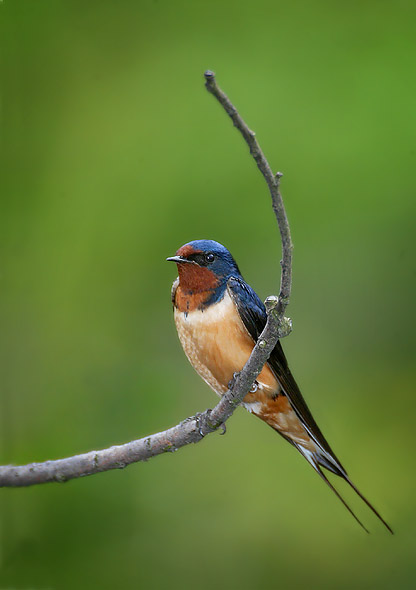
Barn Swallow, Hirundo rustica.
Birds in Science:
Men who put on a little pot belly after marriage can give thanks that they are not barn swallows, Hirundo rustica (pictured above). A study published on Thursday shows females of that species keep shopping around even after mating. Male barn swallows have red breasts. A females likes them to be dark red. If she mates with one male and finds another with a darker breast, she'll dump her first mate. "For male swallows the mating game is never over," says Rebecca Safran, a Cornell University researcher who led this study. "It is dynamic and continual. This is something that most humans can relate to -- think of how much time and money we spend on our looks and status long after we have established stable relationships." The consequences in the avian world for this indiscreet behavior might sound familiar, too. Half of all male barn swallows care for at least one little one that was fathered by a competitor. Some males raise an entire nest of illegitimate young. In this research, some males were given a "make over" with a red marker to make their breasts darker. Those who'd gotten make overs fathered a "substantially larger percentage of offspring" the second time around, according to DNA analysis. The unaltered males fared the same as before or worse. This elegant research is published today in the top-tier peer-reviewed journal, Science.
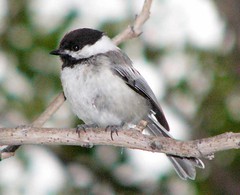 Who would have guessed that when a chickadee opens its tiny beak, it has a lot to say? Biologists studying the alarm calls of black-capped chickadees, Poecile atricapilla (pictured), found the bird’s songs signal not only the presence but also the size of nearby predators. “This level of complexity is certainly new, in terms of alarm responses especially,” says Chris Templeton of the University of Washington in Seattle. His study shows chickadees have one of the most sophisticated means of communication discovered in animals. “Most of the variations are really subtle and are too fine to pick up with our ears,” Templeton says. “But one of them we can hear is the dee.” The more dangerous the predator, he says, the more dee notes in their eponymous chick-a-dee-dee-dee call. The biologists also found that the more dees in an alarm cry, the larger the mob of other chickadees that formed to attack the intruder and the closer they approached in their attacks. “The more closely we look at animal calls, the more information we find,” Templeton says. “It’s surprising and really exciting to know that there is such sophisticated information being passed along in the calls you can hear almost every day.” GrrlScientist says: How can you not love birds after reading a story like this?
Who would have guessed that when a chickadee opens its tiny beak, it has a lot to say? Biologists studying the alarm calls of black-capped chickadees, Poecile atricapilla (pictured), found the bird’s songs signal not only the presence but also the size of nearby predators. “This level of complexity is certainly new, in terms of alarm responses especially,” says Chris Templeton of the University of Washington in Seattle. His study shows chickadees have one of the most sophisticated means of communication discovered in animals. “Most of the variations are really subtle and are too fine to pick up with our ears,” Templeton says. “But one of them we can hear is the dee.” The more dangerous the predator, he says, the more dee notes in their eponymous chick-a-dee-dee-dee call. The biologists also found that the more dees in an alarm cry, the larger the mob of other chickadees that formed to attack the intruder and the closer they approached in their attacks. “The more closely we look at animal calls, the more information we find,” Templeton says. “It’s surprising and really exciting to know that there is such sophisticated information being passed along in the calls you can hear almost every day.” GrrlScientist says: How can you not love birds after reading a story like this?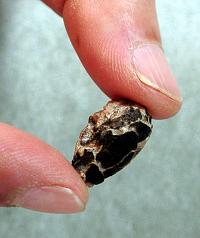 Scientists say they have found the smallest dinosaur eggs ever (pictured) — not counting bird eggs, which could be called dinosaur eggs since scientists believe birds are living dinosaurs. The four eggs, two of which contain remains of embryos, come from a dinosaur that may also turn out to be the smallest known, the researchers said. The eggs are about 18 millimeters (0.7 inch) long, roughly the width of a thumbnail. This makes them about as big as goldfinch eggs, said Eric Buffetaut of the National Center for Scientific Research in Paris, one of the discoverers. The eggs come from a theropod, he said, a type of dinosaur that included the famous Tyrannosaurus Rex and is also believed to be the group from which birds descend. Indeed, the newfound eggs seem to come from a sort of tiny dinosaur-bird who lived at the cusp of the transition between the two forms, Buffetaut said. The eggs were dated to the early Cretaceous, a period spanning from about 145 million to 100 million years ago. The non-avian dinosaurs died out much later, about 65 million years ago. They described the eggs in the September 13 issue of the peer-reviewed German scientific journal Naturwissenschaften (Natural Sciences).
Scientists say they have found the smallest dinosaur eggs ever (pictured) — not counting bird eggs, which could be called dinosaur eggs since scientists believe birds are living dinosaurs. The four eggs, two of which contain remains of embryos, come from a dinosaur that may also turn out to be the smallest known, the researchers said. The eggs are about 18 millimeters (0.7 inch) long, roughly the width of a thumbnail. This makes them about as big as goldfinch eggs, said Eric Buffetaut of the National Center for Scientific Research in Paris, one of the discoverers. The eggs come from a theropod, he said, a type of dinosaur that included the famous Tyrannosaurus Rex and is also believed to be the group from which birds descend. Indeed, the newfound eggs seem to come from a sort of tiny dinosaur-bird who lived at the cusp of the transition between the two forms, Buffetaut said. The eggs were dated to the early Cretaceous, a period spanning from about 145 million to 100 million years ago. The non-avian dinosaurs died out much later, about 65 million years ago. They described the eggs in the September 13 issue of the peer-reviewed German scientific journal Naturwissenschaften (Natural Sciences). People Helping Birds:
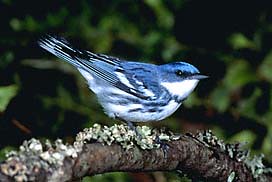 Fundacion ProAves and the American Bird Conservancy (ABC) announced the purchase of land in the South American country, Colombia, to protect a migratory songbird, the Cerulean Warbler, Dendroica cerulea (pictured), that winters there but breeds in Canada. The purchased land includes 500 acres of subtropical forest in the Rio Chucuri Basin of Santander, within the Serrania de los Yariguies IBA (Important Bird Area) and will also protect Colombian endemics such as the globally threatened Gorgeted Wood-quail, Odontophorus strophium and Mountain Grackle, Macroagelaius subalaris. ProAves estimates that the population of Gorgeted Wood-Quails in Serrania de los Yariguies may be in excess of 250 birds, which would make the area the global stronghold for the species.
Fundacion ProAves and the American Bird Conservancy (ABC) announced the purchase of land in the South American country, Colombia, to protect a migratory songbird, the Cerulean Warbler, Dendroica cerulea (pictured), that winters there but breeds in Canada. The purchased land includes 500 acres of subtropical forest in the Rio Chucuri Basin of Santander, within the Serrania de los Yariguies IBA (Important Bird Area) and will also protect Colombian endemics such as the globally threatened Gorgeted Wood-quail, Odontophorus strophium and Mountain Grackle, Macroagelaius subalaris. ProAves estimates that the population of Gorgeted Wood-Quails in Serrania de los Yariguies may be in excess of 250 birds, which would make the area the global stronghold for the species.At the same time that our own domestic laws that protect wildlife from the ravages of humans are being weakened, the United States announces a global coalition against wildlife trafficking. Wildlife trafficking -- the illegal trade in wildlife and wildlife parts -- is a soaring black market worth $10 billion a year. Unchecked demand for exotic pets, rare foods, trophies and traditional medicines is driving tigers, elephants, rhinos, unusual birds and many other species to the brink of extinction, and threatening global biodiversity. Added to this is the alarming rise in virulent zoonotic diseases, such as SARS and avian influenza, crossing species lines to infect humans and endanger public health. GrrlScientist note: While I applaud this move, I am still mystified by why our leaders think we can "police the world" in this matter when we ourselves need a little policing?
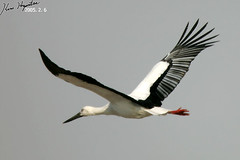 Five white storks flew into open skies from a park in Hyogo Province in western Japan on Saturday as part of an effort to return the endangered species to the wild. Prince Akishino and his wife, Kiko, cut a red-and-white ribbon to open a box and release the first of the five storks. Thousands of spectators cheered as the white birds with black-edged wings flew away. It was the first time that artificially bred Oriental white storks, Ciconia boyciana (pictured), had been released, a park official said. Japan's last wild stork died in protective captivity in 1971.
Five white storks flew into open skies from a park in Hyogo Province in western Japan on Saturday as part of an effort to return the endangered species to the wild. Prince Akishino and his wife, Kiko, cut a red-and-white ribbon to open a box and release the first of the five storks. Thousands of spectators cheered as the white birds with black-edged wings flew away. It was the first time that artificially bred Oriental white storks, Ciconia boyciana (pictured), had been released, a park official said. Japan's last wild stork died in protective captivity in 1971. In an effort to combine forest conservation with long-term poverty reduction, BirdLife is covering Brazil's Atlantic forest with chocolate. The project aims to restore the traditional cabruca method, which uses the shade of native forest trees to protect the cacao crop. "As farmers convert to slash-and-burn agriculture, or environmentally destructive and economically unproven alternatives such as coffee and pasture, the remaining forest is being lost without any lasting benefits to the rural poor," Jaqueline Goerck of SaveBrasil (BirdLife in Brazil) explained. "With an upturn in the cacao market, the rejuvenation of cabruca lands using organic agroforestry offers an alternative source of sustainable income for the forest/farming communities."
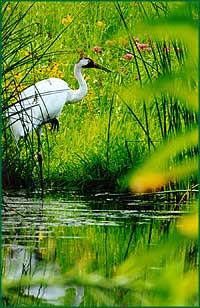 Finally (!), a legal judgement will be handed down for the seven armed and dangerous idiots who shot and killed two endangered Whooping Cranes, Grus americana (pictured), in Kansas last year. When arrested and charged with crimes against nature, these seven armed and dangerous idiots whined to wildlife officials that they all mistook the endangered cranes for legally hunted sandhill cranes on a November 6 Stafford County goose and sandhill crane hunting trip. Sportsmen and wildlife enthusiasts are justifiably upset by the shooting. Jim Kellenberger, a longtime hunter education instructor, said misidentification is not an excuse. "We teach kids you never, ever, pull the trigger if you can't make 100 percent positive identification," Kellenberger said. "This was a horrendous thing." Initially officials said penalties could reach $100,000 and up to one year in jail under the Endangered Species Act but they later wimped out by reducing the maximum penalties to no more than six months in jail and a mere $15,000 fine. Officials think there are fewer than 300 whooping cranes currently in the wild. GrrlScientist says; It would have been so "Darwinian" if they had shot each other instead, thereby removing seven armed and and dangerous idiots with severe vision problems from the world.
Finally (!), a legal judgement will be handed down for the seven armed and dangerous idiots who shot and killed two endangered Whooping Cranes, Grus americana (pictured), in Kansas last year. When arrested and charged with crimes against nature, these seven armed and dangerous idiots whined to wildlife officials that they all mistook the endangered cranes for legally hunted sandhill cranes on a November 6 Stafford County goose and sandhill crane hunting trip. Sportsmen and wildlife enthusiasts are justifiably upset by the shooting. Jim Kellenberger, a longtime hunter education instructor, said misidentification is not an excuse. "We teach kids you never, ever, pull the trigger if you can't make 100 percent positive identification," Kellenberger said. "This was a horrendous thing." Initially officials said penalties could reach $100,000 and up to one year in jail under the Endangered Species Act but they later wimped out by reducing the maximum penalties to no more than six months in jail and a mere $15,000 fine. Officials think there are fewer than 300 whooping cranes currently in the wild. GrrlScientist says; It would have been so "Darwinian" if they had shot each other instead, thereby removing seven armed and and dangerous idiots with severe vision problems from the world.Birds and Hurricanes:
How did hurricane Rita affect migrating songbirds? For millennia, the Gulf of Mexico's autumn hurricanes have butted gale-force winds against the southbound journeys of migrating birds. Somehow, the birds sense storm paths and survive. ''This is not new to birds,'' Cliff Shackelford, an ornithologist with the Texas Parks and Wildlife Department, said Friday as Hurricane Rita began lashing the central Gulf Coast. ''Birds can detect things like barometric pressure, changes in wind. ... With a storm like Rita, [that is] so big it's covering the whole ... Gulf, they're not going to take that first step.'' The Texas coast acts as a funnel for birds migrating from North American summer grounds to wintering havens in Central and South America. Scientists debate whether hurricanes are worsening due to global warming or due to a repeating cycle. Either way, the biggest problem if the trend continues may be destruction of the already dwindling habitat of birds living year-round on the Gulf, such as the long-legged herons and egrets that wade in salty marshes. ''I'm more worried about the resident birds,'' Simon said. ''They're not used to going anywhere.''
Avian Zoonotic News:
The Food and Agriculture Organisation (FAO) said its appeal in May for $100 million to fight avian flu in animals for the next three years had received a lukewarm response so far. "The circulation of so much influenza virus in animals in many countries in close proximity to humans remains a major risk factor that could trigger a pandemic," the FAO said in a statement. Bird flu has killed 65 people in four Asian countries since late 2003 and has been found in birds in Russia and Europe. Experts fear that the most deadly strain, the H5N1 virus which has the power to kill one out of every two people in infects, could set off a pandemic if it gains the ability to be transmitted easily between humans. The FAO said there was a "small window of opportunity" to reduce levels of infection through vaccination before winter.
Singapore scientists have developed a quick Bird Flu test that can detect bird flu infections in poultry within four hours. This is a tool that could help health officials control the spread of the deadly virus because in the absence of a vaccine, early identification of the virus is especially important, and current tests used by laboratories take two to three days and sometimes up to a week to produce results. The faster you are able to detect the H5N1, the earlier you can impose some kind of isolation procedure and the faster poultry can be culled to prevent the spread of the virus," Ren Ee Chee, a professor at the Genome Institute of Singapore who led the research team, told Reuters. "We have tested on over a hundred avian samples in Vietnam and Malaysia. So far, the accuracy rate is 100 percent," Ren said, adding the kits were designed to identify the gene specific to the H5N1 strain, so they would be able to detect bird flu infections in both animals and humans. The team is currently testing the kits on human samples.
A species of mosquito common in the eastern U.S. and capable of carrying the West Nile virus has made its way to the Midwest for the first time, a finding made by a college undergraduate, Washington University officials said Monday. Stephanie Gallitano, a Washington University junior chemistry major from Chicago, was studying the egg-laying habits of mosquitoes native to Missouri this summer at the Tyson Research Center in Eureka, Mo. She took eggs to a lab and some developed into a type of insect she didn't recognize. "Under the microscope, they looked completely different than anything I'd ever seen before," Gallitano said. "It had different proportions for its body. I looked through all of the books and could find nothing like it." It turned out to be an invasive Asian mosquito known as Ochlerotatus japonicus, and marked the farthest west the species has been seen in the central United States, according to the Chevy Chase, Md.-based Howard Hughes Medical Institute. Gallitano's field work was part of an HHMI summer research project.
Streaming Birds:
I love BirdNote and I want you to enjoy it, too, dear readers. Featured this week are answers to your burning bird questions that keep you awake at night; the crows' night roost; migration: innate or learned?; a two-part series about how high birds fly (with a photo of a Ruppell's Griffon); and last but not least, how the migration of the Black Brant, Branta bernicla nigricans, has changed along the West Coast. Click here to access this week's schedule and photographs of the avian "stars". BirdNote shows are two-minute vignettes that incorporate the rich sounds of birds with stories that illustrate the interesting -- and in some cases, truly amazing -- abilities of birds. BirdNote can be heard Monday through Friday, 8:58-9:00AM, throughout Western Washington and Southwest British Columbia and is also available as RSS/Podcast feeds.
Miscellaneous Birds:
All you budding pirates probably wonder what is it like to live with an African Grey Parrot on a boat? This story gives you an idea of what life is like on the high seas with a companion parrot.
What do we learn by banding wild birds? This story discusses how wild ducks are trapped and banded, and what we learn about them as a result of giving each bird its own individually numbered and registered legband.
Thanks to bird pals, Ian, Ellen, Kathy, Scott, Ron and anonymous for some of the links that you are reading here. Thanks to Ian for corrections to this document. Please accept my apologies for being so late publishing this edition of Birds in the News.
Previous : : Birds in the News : : Next
© 2004, 2005, 2006 by GrrlScientist











1 Peer Reviews:
Kansas hunters get a light sentence for shooting Whoopers: $3000 and 2 yr suspension of hunting (see link below). Considering the cost of raising and monitoring this endangered species they could have at least paid more for the recovery costs.
http://www.kansas.com/mld/kansas/12784466.htm
Post a Comment
<< Home